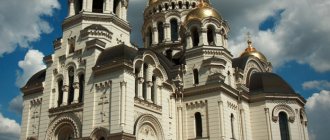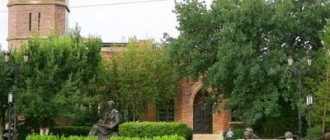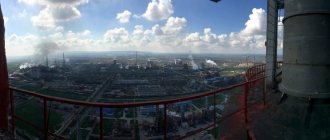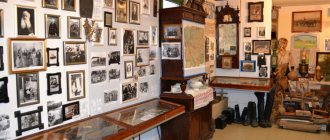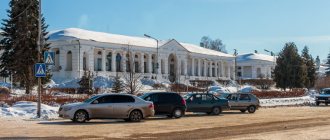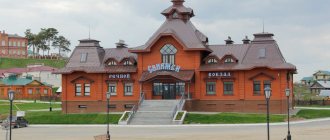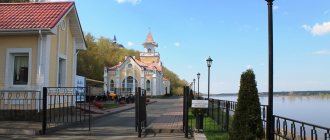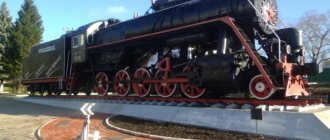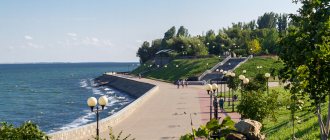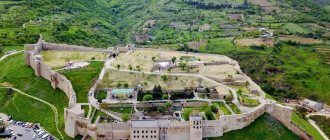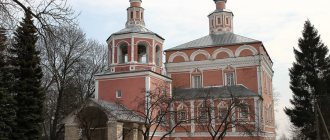Sights of Novocherkassk. The most important and interesting sights of Novocherkassk - photos and videos, descriptions and reviews, location, websites.
- Last minute tours
to Russia
Novocherkassk appeared in 1805 as the capital of the Don Army Region. At first there were only administrative and residential buildings, taverns, hotels and parks. Industrial enterprises were practically absent. The composition of the population was also very atypical: in addition to Cossacks with their families, nobles and clergy lived in the city; there were negligible representatives of the merchant and peasant classes. During the Civil War, the city was one of the centers of resistance to the Bolsheviks, and after the final victory of the Red Army it lost its special status. In the 1990s. Novocherkassk again became a stronghold of the Don Cossacks.
Patriarchal Ascension Cathedral Military Cossack Cathedral and Ermak Square
The main attraction is located in the city center - the Patriarchal Ascension Cathedral of the Cossack Military Cathedral, the third largest in Russia. The height of the cathedral is 74.6 m . The beginning of construction is the year the city was founded.
They designed and tried to build the cathedral twice. But due to weak soils and the presence of groundwater at shallow depths, the construction of such a massive structure could not be completed. Each time the cathedral collapsed; under the weight of its own mass it sank into the ground. The Cossacks decided to make the third and last attempt according to the project of A.A. Yashchenko. Construction was completed in 1904, and in 1905 the cathedral solemnly opened its massive carved doors in the presence of Nicholas II.
The cathedral is active, services are held in it, and the temple is beautifully decorated on church holidays. At night, the facades of the cathedral are illuminated by architectural lighting depicting scenes from the Bible. The main cross is decorated with rock crystal. In the basement of the cathedral, which has two tiers, baptisms are performed and the tomb is located. Marble sarcophagi store the remains of the founder of Novocherkassk M.I. Platov and other personalities significant for the history of the city. The interior of the cathedral is impressive: frescoes, paintings, and stained glass windows depict biblical scenes and pictures from the life of the Cossacks. Excellent acoustics can be enjoyed during festive services, which are accompanied by the singing of the church choir.
The cathedral is located on Ermak Square, paved with stone. There are also three monuments here. The first one, on the side of Ermak Avenue, is a monument to Ermak, the famous Don Cossack and conqueror of Siberia. It was opened in 1904 and has remained unchanged to this day.
On the other side of the cathedral in 1911. A monument to the hero of the Caucasian wars, Lieutenant General Ya.P. was opened, brought from St. Petersburg. Baklanov. His ashes are also kept in the cathedral crypt. The monument was heavily damaged during the First World War, but was completely restored in 1995.
On the side opposite the main entrance of the cathedral in 2005. a monument of reconciliation and harmony was erected, symbolizing the unity of the Cossacks and their reconciliation with their enemies.
Location: Ermaka Avenue.
Ascension Cathedral
The main temple of the Don Cossack Army began to be built immediately after the founding of the city at the beginning of the 19th century, but the work lasted for as much as 100 years. During Soviet times, the cathedral was closed and the premises were used for household needs, but in the 1950s. The authorities, understanding the architectural value of the building, began its restoration. As a result of the last reconstruction in the 2000s. the temple turned into a monumental and luxurious structure. From the outside, it looks like a typical church remodel - neo-Byzantine style superimposed on modern construction technologies. The façade and interior are decorated with Italian marble and rock crystal. On the walls hang canvases telling about the history of the Cossacks.
The tomb contains the remains of Ataman M.I. Platov, the founder of Novocherkassk.
Address: pl. Ermaka, 2.
- Ascension Military Cathedral
Triumphal arches
On the western and northern sides of the city, by order of Platov, two identical arches were built in the style of late classicism. Since the city was located on a hill, from the north side you can clearly see the city’s microdistricts (villages) and the river. In addition, the arch is beautifully illuminated at night. The northern arch is located on the street. Herzen, and separates the central part of the city from the villages.
The second arch is located near the Azov market. From this place you can admire the Aksai hills and the villages adjacent to the city.
IntroductionTour of the city of Novocherkassk
Of all the cities in the Rostov region, Novocherkassk, perhaps, has preserved the architectural and planning structure of the 19th century better than others. The old part of the city has been declared a protected architectural zone.
In our city there are about 200 historical and architectural monuments, of which 12 are federal, about 60 are regional and more than 100 are local.
Novocherkassk became the fifth capital of the Don Cossacks. The city appeared thanks to Ataman M.I. Platov, urban planner Franz de Vollan and Emperor Alexander I. Unlike Rostov-on-Don and Taganrog, which initially arose as fortress cities, which later largely determined their urban planning structure, Novocherkassk was founded in a completely new place and with a different purpose.
There were several reasons for moving the capital. Cherkassk suffered from strong floods of the Don every spring and remained cut off from the rest of the Cossack territories for a long time. There were numerous unsuccessful attempts to rebuild Cherkassk. It was proposed to raise it onto an artificially constructed embankment, or dig bypass canals around the city and thereby protect it from the spring floods of the Don. And in winter, summer and autumn, continuous wooden buildings without a master plan led to frequent fires.
On May 18, 1805, on the day of the Ascension of the Lord, New Cherkassk was founded. In the place where the cathedral now stands, the Cossacks walled up a silver plate with the coat of arms of the Don Army and coins from 1805. Furrows were laid with plows, marking the first avenues and streets of the future capital.
The new capital of the Don Cossacks was built as the administrative center of the Don Army Region, and this was also its peculiarity. The construction of plants and factories was not envisaged at all on the territory of the city.
At different times the name of the city was written differently. There were options for continuous, separate, hyphenated spelling, with one and two letters “s”. Modern spelling has been the norm since 1888.
Most of the buildings in Novocherkassk bear the imprint of the late classicism or empire style, which firmly held their position until the end of the 19th century. The passion of Novocherkassk architects for classicism is quite understandable. The regular layout of the city and the claim that it was the capital of the administrative center of the Don Army obliged them to comply with a given construction program.
Projects for the main public buildings, temples and other structures being erected in the capital of the Don Cossacks under construction, as a rule, were drawn up by famous metropolitan and talented local architects in the then dominant architectural styles. Currently, many of them are architectural monuments.
Ataman Palace
A small two-story building in the city center located at the intersection of Platovsky Avenue and Moskovskaya Street. Made in classicism style. On the façade there is an elegant balcony with cast lattice and open portals at the entrances. The palace was designed and built by I.O. Valprede in 1863.
The Ataman Palace was the residence of high-ranking officials, including the emperor during his visit to the city. Now it is a branch of the Museum of the Don Cossacks. On the first floor there is an exhibition of various museum exhibits, on the second floor a gallery of interiors is recreated with impressive beauty and richness of decoration: state rooms, the ataman’s office, a dining room, a large living room. In front of the palace there is a small park with a fountain.
Location: Dvortsovaya street - 5a.
Novocherkassk
(brief historical sketch) (part 1)(part 2)(part 3)(part 3 ending)
Pre-revolutionary history of Novocherkassk
Kreschenki Descent
On August 23, 1804, Emperor Alexander 1 approved the proposal of “Mr. Lieutenant General, Don Military Ataman Platov” on the founding of a new city on the Don, which would be “called New Cherkassy.” The construction plan for the new Cossack capital, developed by engineer Lieutenant General F.P. Devolan, was considered by the Highest and approved by the inscription: “Be it according to this. Alexander. St. Petersburg. December 31st day 1804."
May 18, 1805 On the day of the great Orthodox holiday of the Ascension of the Lord, the historical celebration of the foundation of the new capital of the Don and the military temple took place. The foundation of the Ascension Cathedral proposed for construction was laid with a “silver-gilded board” in a gilded casket with the inscription: “The city of the Don Army, called New Cherkassk, was founded during the reign of the Sovereign Emperor and Autocrat of All-Russia Alexander the First, in the year of our Lord 1805 May 18, which to this day existed for 235 years on the banks of the Don on an island from this place directly south at a distance of 20 miles called Cherkassk.”
The transfer of the Cossack capital from Cherkassk to a new place called Biryuchiy Kut (“wolf’s lair”) was caused by many economic, socio-political and even environmental reasons. One of them was the almost annual long-term flooding of Cherkassk by the waters of the Don overflowing in the spring. Another reason was frequent fires in the former Cossack capital, built chaotically, without a master plan, in the fire of which up to half of the crowded wooden buildings burned out. The festively arranged move to New Cherkassk took place on May 9, 1806. Old Cherkassk saw off the solemn procession to the new capital with a cannon salute. New Cherkassk met the first settlers led by Voyskov Ataman M.I. Platov 101 cannon shot. A historical act of successive transmission of military, cultural, moral and other traditions of the Don Cossacks from the inhabitants of the former capital to the new one took place.
At the beginning, the construction of New Cherkassk proceeded slowly, since the Don Army devoted a lot of effort and resources to Russia’s fight against Napoleon (from 1805 to 1814). However, already in 1810, a two-story stone house of General Kurnakov, a wooden police building on Moskovskaya Street, wooden Alexander Nevsky and Trinity prayer houses, a wooden cemetery church in the name of St. appeared in the city. Demetrius of Thessaloniki, the building of the “prison castle”, etc. October 1, 1811 In a solemn ceremony, the stone military Ascension Cathedral was laid, designed by the architect L.I. Rusko. The leisurely construction and slow settlement of New Cherkassk was determined, first of all, by the fact that the place for the construction of the new capital was chosen by Ataman M.I. Platov in the waterless steppe in the hope of eliminating any possibility of Don spills and flooding of the new capital. But this extreme had a flip side to the coin. They began to build the city “on the mountain of the Cossacks on the mountain.” And not only did the residents of the new capital find themselves practically without water, they also found themselves cut off from the usual trade and communication route, which historically was the Don for them. New Cherkassk was built 20 versts from the Don. It stood on the top of a steppe hill, the foot of which was washed on both sides by two shallow, non-navigable rivers - Tuzlov and Aksai. All many years of attempts to clean and deepen their riverbeds and to channel Don water through them were unsuccessful. The city continued to suffer from lack of water, dust, and dry steppe winds, which caused justifiable discontent among the Cossacks forcibly resettled from Cherkassk. This continued until 1836, when the next and now last attempt of the Cossacks to persuade Emperor Nicholas 1 to move the capital closer to the deep Don failed. Minister of War A.I. Chernyshev, on behalf of the Tsar, notified the Military Ataman M.G. Vlasov about the advisability of preserving “Novocherkassk in its current place.” From that time on, the construction and development of Novocherkassk proceeded at a faster pace. Two “working regiments” of non-combatant Cossacks worked intensively, filling up inner-city gullies and ravines, paving streets, building military buildings, transporting building materials, etc.
By the middle of the 19th century, Novocherkassk began to acquire its characteristic architectural forms. From the distance of the steppe one could see the beautiful three-story stone snow-white building of the “Military Offices” built in 1844 on Platovsky Prospekt (now the building of the Communications School opposite the Department Store). In 1846, a solid two-story stone house of the Society of Don Trade Cossacks (now the Pobeda cinema) appeared on Moskovskaya Street. In 1850, at the corner of Cathedral Square and Platovsky Prospekt, a beautiful two-story stone building of the Noble Assembly was built. Along with them, modern stone Gostiny Dvors, taverns, wine cellars, hotels, houses of generals and nobles, city gardens, etc. appear. Despite the fact that the city developed as a military administrative center, nevertheless, industry gradually appeared in it. So, in the 40s, a cloth factory began to operate, and in the mid-50s there were already 26 small brick factories using local raw materials, 67 forges, 31 windmills, 6 lard factories, 2 breweries, several wineries producing up to 55 thousand. buckets of wine a year. There were many handicraft workshops and small enterprises for processing agricultural products. But all these industries employed less than 1,000 people. with a population of almost 20 thousand in Novocherkassk.
In 1847 (as for the first time in 1830), cholera came to Novocherkassk, from which 5,000 people died, which amounted to almost a quarter of the population of the Cossack capital. He died after contracting cholera, but not in Novocherkassk, but in the village of Ust-Medveditskaya in 1848. Military Punishment Ataman M.G. Vlasov.
The middle of the 19th century is memorable for Novocherkassk for many remarkable events. May 9, 1853 “Grateful Don residents” solemnly unveils in the center of Novocherkassk a monument (authors-academics: A.A. Ivanov, N.A. Tokarev, P.K. Klodt) to the founder of the city, the most famous Don Ataman, count and holder of many domestic and foreign orders, Matvey Ivanovich Platov. In the same year, the first secondary educational institution on the Don and in the city was opened - the Don Mariinsky Institute of Noble Maidens, which at that time received the rented building of a military hospital on Institutskaya Square (now Pavlova Square, the hospital of the Ministry of Internal Affairs). Later, the institute will enter its own beautiful three-story building on Pochtovaya Street (now Pushkinskaya Street, the building of the Novosibirsk State Medical Academy). In the next one, i.e. In 1854, work was carried out in the city to lay out and plant three gardens: Aleksandrovsky, Botanical (Aptekarsky) and Institutsky. Some city avenues were covered with paving stones.
Active urban planning policy of the Military Ataman M.G. Khomutova manifested herself in the creation of particularly important objects for the city. With him in 1861 Construction of the railway through Novocherkassk began. On his initiative in 1863. from the back side of the monument to M.I. Platov was built according to the design of academician of architecture I.O. Valpreda Ataman Palace. Under his successor Ataman P.Kh. Grabbe January 1, 1864 The first locomotive whistle notified the residents of the Cossack capital about the beginning of “correct movement on the Grushevsko-Donskaya railway.” Soon Novocherkassk receives a city water supply system, built according to the design and under the leadership of engineer A.V. Belelyubsky. He brought Novocherkassk into the top ten cities in Russia that had city water supply at that time. With its launch on December 7, 1865. the city has noticeably improved the water supply to its citizens, but not enough to solve this problem completely. The subsequent growth of the city's population repeatedly raised questions about both the reconstruction of the existing one and the construction of a new, more powerful water supply system. The problem of water supply for Novocherkassk turned out to be so acute that its solution has continued to this day with varying degrees of success.
Important events in the cultural life of Novocherkassk were: construction in 1866. wooden theater building, designed by architect A. Campioni and the beginning of publication of the first private newspaper on the Don, “Donskoy Vestnik” (later “Donskaya Gazeta”, editor A. Karasev). In 1867 In Novocherkassk, the Don Mariinsky Women's Gymnasium opens its activities, which later (1883) received a beautiful three-story building on Atamanskaya Street, built according to the design of academician of architecture A. Yashchenko (now the building of the Agrarian College, next to the museum, opposite the drama theater). A year later, or more precisely on October 1, 1868, the Don Theological Seminary opened, receiving the same title in 1883. a beautiful two-story building on Platovsky Prospekt (now the educational building of the College of Communications), also created according to the design of A. Yashchenko. Two years later (1869) a Cossack police school was opened in Novocherkassk, and on its basis in 1870. — Novocherkassk Cossack Junker School.
1870 became a anniversary year. On May 22, in the presence of the Sovereign Heir Alexander Alexandrovich, the August Ataman of all Cossack troops and his wife the Empress Tsesarevna, 3-day celebrations began in the city on the occasion of the 300th anniversary of the Don Army, officially recognized by the Moscow Tsar Ivan the Terrible in a letter to the Don dated January 3, 1570 For services to the Fatherland, the Don Cossacks were most highly awarded the St. George Banner with the Alexander Ribbon, on which the embroidered words sparkled in gold: “in memory of the three-hundred-year existence of the Don Army.”
Bazarnaya street
The last quarter of the 19th century was characterized by rapid urban development in Novocherkassk and the opening of many military and civilian educational institutions. So, in 1876 The men's classical gymnasium (in the future Platovskaya), opened back in 1805, received its huge two-story stone building on Ermakovsky Prospekt, built according to the design of the architect A. Campioni (now school ©3). In 1877 Several educational institutions are opening. Among them is the Aleksandrovskoe Real School, originally located in a 2-story mansion rented from Fomina at 47 Aleksandrovskaya Street (now the building of the Criminal Procedure Code). In the same year, the Teachers' Seminary opened, which later received a 2-story building for its classes at the corner of Platovsky Ave. and Pochtovaya Street. (now the building of the Suvorov School of the Ministry of Internal Affairs). September 21, 1878 The Military Paramedic School on Kreshchensky (now Krasny) Descent begins classes. In 5 years, i.e. in 1883 The grand opening of the Don Cadet Corps took place in Novocherkassk. May 6, 1885 the groundbreaking took place, and 5 years later (1889) the construction of the complex of buildings of the Don Emperor Alexander 111th cadet corps (now the building of the Don Ministry of Internal Affairs division) was completed. In 1886 On Ermakovsky Prospekt © 46, the Military Craft School opened (now the chemical plant management building), and in 1888 the Ataman Technical School began its classes, housed in a beautiful 3-story stone building on Mikhailovskaya Street (now the building of the Mechanical Engineering College on the street. Kirov). In 1889 In the adapted building, the Don Diocesan Women's School opened its activities, and soon (1894) received at its disposal a huge 3-story stone building specially built according to the design of the architect Studenikin on Platovsky Prospekt (now the educational building of the NSMA).
In the same 80s, large-scale improvement work and, in particular, landscaping were carried out in Novocherkassk. Thanks to the vast experience and initiative of the forester F.F. Tikhonov, groves are planned and planted in the city: in 1880. Krasnokutskaya (in memory of the Military Ataman N.A. Krasnokutsky, now the “Red Spring” grove in the Cheryomushki region), in 1886. — Kadetskaya (now Chapaev Square), in 1888. - Nikolaevskaya (now the territory of NSTU and NGMA), and in 1890. - Junkerskaya. In the same year, a stone bridge was built across the Tuzlov River behind the St. Petersburg Descent (now Herzen Descent), and the central city cemetery was fenced with a stone fence. In 1890 The Don Military (Officers) Assembly began its practical activities, located in a building completed and rebuilt by the architect V.I. Zuev on the corner of Moskovskaya and Komitetskaya streets (now the building of the A.S. Pushkin Library).
The last decade of the outgoing 19th century was notable for Novocherkassk for a number of events. On December 12, 1893, “in front of a large crowd of people,” with the care of the abbess of the Starocherkassk Efremov convent, Abbess Innocentia, the construction of the “monastic” church “Joy of All Who Sorrow”, designed by architect A.S. Kaminsky, was completed. In 1896 next to the dilapidated wooden “Ataman” Alexander Nevsky Church, a magnificent stone temple is being built according to the design of the architect Anokhin. Two years later (1898), on Kolodeznaya Square (now Mayakovsky Street), with donations from parishioners, a stone church in the “Russian style” was built in the name of St. George the Victorious. In the same year, on Mikhailovskaya Street (now Kirova Street), the Lutheran Church, built according to the design of the architect N.I. Roller, rises high into the sky with a Gothic spire. In 1898 E.D. Petrova’s private preparatory boarding school began its activities, which at the beginning of the twentieth century became the first private gymnasium on the Don for co-education of boys and girls with student rights. The grand opening on November 22, 1899 was a bright final chord of the outgoing 19th century. the first Donskoy Museum in the Cossack region in a special building on the corner of Platovsky Ave. and Atamanskaya Street. Its first director was appointed the famous local historian, great connoisseur and active collector of Don antiquities Khariton Ivanovich Popov.
At the beginning of the twentieth century, church construction in Novocherkassk continued. In 1903 on Ratnaya Square (now a complex of NSTU buildings with a canteen and a student clinic) a beautiful, as if stone-carved, Church of the Don Icon of the Mother of God is being built. May 6, 1905 after almost a century of construction (with the collapse of the 1st and 2nd versions), a crowded celebration of the consecration of the “second sun of the Don” - the Military Ascension Cathedral - took place. The age-old dream of the Don Cossacks has come true - to have their own majestic military temple, worthily continuing the best age-old traditions of the “great-grandfather of all Don churches” - the Starocherkassk Resurrection Cathedral, built under Peter the Great in 1719. Novocherkassk Cathedral rightfully took 3rd place (after St. Isaac's in St. Petersburg and Christ the Savior in Moscow) among the most majestic cathedrals of the then Russia. He could receive up to 5 thousand Orthodox parishioners for one service. In 1908, near the Alexander Garden on Pochtovaya Street. (now Pushkinskaya Street) the stone Old Believer Nicholas Church was consecrated (the building has not survived; a 4-story building of the city fire brigade stands on this site). Two years later, instead of the wooden Church of Constantine and Helena, built on Sennaya Square for the needs of the Cossacks of the 2 “working regiments” that were equipping the city, a stone temple was built and consecrated. And the next year, 1910, not far from Prince Svyatopolk-Mirsky Square (now Pavlov Square, near the distillery) in the lane. A stone church is being built in the name of Seraphim of Sarov. This was the last parish church built in pre-revolutionary Novocherkassk.
Cathedral
It is natural to assume that in Novocherkassk, along with parish churches (that is, those with their own parishioners), chapels and house churches were established. In total, up to 10 different chapels operated in the city at different times. Among them: the most famous chapel of Alexander Nevsky (1881) on Platovsky Prospekt, a chapel at the Azov market (1889), a chapel (1892) in the Alexander Garden (opposite the Main Post Office building), a chapel at the city cemetery (in memory of those killed on the battlefields of the First World War), a chapel at the Khotun Cemetery (the area next to the plane-monument to the fallen pilots), at the “infectious cemetery” on the Three-Crest Meadow (in the area of Biryuchekutskaya station), at the Trinity Bazaar (now the Sennaya Market), at the city morgue in the hospital “ Society of Don Doctors" (now Emergency Hospital on Krasnoarmeyskaya Street), etc.
House churches were established in military, military and civilian institutions to meet the religious needs of people working or studying there. The first house church was consecrated (1834) in the name of the Kazan Mother of God in the new Bishop's House (now the building of the House of Officers on Ermaka Square). In 1869 on the left side of the Ataman Palace on the second floor, a church in the name of Simeon the Persian is consecrated (now the office of the head of the financial department of the Administration). In 1886 The St. Nicholas Church in the Donskoy Emperor Alexander 111th Cadet Corps is consecrated. Three years later, a house church opened in the name of St. Barbarians at the Donskoy Mariinskaya Women's Gymnasium. In 1890 The Holy Spiritual Church was consecrated in the building of the local Cossack team, and in 1891. — in the new building of the Donskoy Mariinsky Institute of Noble Maidens in the name of St. Magdalene. In 1894 A church in the name of the Most Pure Mother of God is built and consecrated in the new building of the Don Diocesan Women's School. December 12, 1898 The Church of the Archangel Michael in the Novocherkassk Cossack Junker School is consecrated. Other house churches include the following: the Intercession Church (1868) in the Novocherkassk Theological School, the Church of Cyril and Methodius in the men's classical gymnasium, the Church of St. John the Evangelist in the Don Theological Seminary (1883), the church at the “prison castle” in the name of John. warrior (1891), as well as house churches at the Ataman Technical School, at the Excise Department.
Not only Orthodox churches and chapels operated in Novocherkassk, but also heterodox ones. Before the revolution, the Old Believer Church was persecuted by both the Russian Orthodox Church and the tsarist government. Therefore, the “Old Belief,” despite having a common origin with Orthodoxy, was considered sectarian, “harmful.” In the city since 1889 The Edinoverie Assumption Church operated on Assumption Square (now Kirov Square), designed to legally unite the Old Believers with Orthodoxy. In 1898 The Lutheran Church on Mikhailovskaya Street is consecrated. (now Kirova St.). In 1903 — a Roman Catholic church was built on Nikolaevsky Ave. (now Prosveshcheniya Street). In 1908, the Old Believer Nicholas Church on Pochtovaya Street was consecrated. (now Pushkinskaya street). Along with them, there were two neighborhood Muslim mosques in the city, one on Khomutovsky Ave. (now Bakunin Street), and the other on the Tatarka farm. The Kalmyk (Lamaist) church, the Khurul, held ceremonies on Khotunka. Before the revolution of 1917 In Novocherkassk, there were over 30 Orthodox churches, prayer houses, house churches and chapels, as well as about 10 non-Orthodox churches.
Don Polytechnic Institute
The beginning of the twentieth century opened a new page in the education system in Novocherkassk. Along with traditional primary schools and colleges, gymnasiums and the Don Mariinsky Institute of Noble Maidens (secondary educational institution), as well as military educational institutions, in the city in 1907. The first higher educational institution opens - the Don Polytechnic Institute. What the Cossacks dreamed of for so long came true. But, if the problem of obtaining higher education in the Don for men was solved, women did not yet have such an opportunity. And then in 1910. private Higher Women's Natural Science Courses were opened (in a rented building on the corner of Komitetskaya and Vospitatelnaya streets (now Frunze Street), where the best scientific forces of the DPI taught part-time. A year later, Novocherkassk received the right to open a Teachers' Institute. It was housed in an old 3 storey mansion on Aleksandrovskaya Street (now the educational building of the College of Food Industry). Later it will be transformed into the Pedagogical Institute. In 1916, on the basis of the previous courses, private Higher Women's Agricultural Courses were opened, on the basis of which in 1918 the Don Agricultural Women's Institute was created.
Naturally, the capital Novocherkassk had a diverse range of educational institutions. Among those previously unnamed, the following worked in the city: Land Surveying School (now the building of SPTU-54 named after Kovalev on Mayakovsky St., 67), the private women's gymnasium of A.D. Duvakina on Atamanskaya St. (now the building of a branch of the Academy of Agribusiness), the private secondary school of Kuznetsov (now the school building © 5), the Mariinsky Women's Shelter on Aleksandrovskaya Street. (now the building of military doctors near the Alexander Nevsky Church), Alekseevsky girls' shelter on Atamanskaya Street. (now a destroyed building between the building of the Agrarian College and a branch of the Academy of Agribusiness), up to two dozen private schools (3rd and 4th categories) and primary schools, as well as 10 parochial schools.
The activities of the Society of Don Doctors were imbued with concern for “people's health”, which in 1913 built at our own expense, according to the design of architect S.I. Boldyrev, a beautiful 3-story building of the “Surgical Hospital” on Ratnaya Street. (now emergency hospital on Krasnoarmeyskaya street). On the former Solyanoy Lane, and now Troitskaya Street, there was a “Hospital for Nonresidents” (a rebuilt building of the currently operating Geological Exploration College). The Don Regional Troops Hospital received patients on Bazarnaya Street (now the infectious diseases hospital on B. Khmelnitsky Street). Along with them, various private medical institutions operated. For example, a private surgical hospital on Moskovskaya Street, Nechaev Hospital on Komitetskaya Street. etc. There were 6 pharmacies at the service of Novocherkassk residents and guests of the capital. At the same time, 6 pharmacy stores operated. In total, 40 doctors, 25 midwives, 6 dentists, etc. conducted private practice in the city.
Monument to Ermak
Guests, both Russian and foreign, often came to the capital Novocherkassk. An extensive network of hotels operated at their service, divided by class of service. The most respectable hotels before the revolution were: “Bolshaya Moskovskaya” on Platovsky Prospekt (now the burnt building of the Yuzhnaya Hotel), “Central”, located nearby, across Moskovskaya Street (now the building with the Platovsky store), “European” on Atamanskaya st. (now a dormitory for NSTU) and “Donskaya” on the corner of Aleksandrovskaya and Pochtovaya streets (the building has not survived). The hotels had lower ranks: “Golden Anchor” on Sobornaya Square. (now Ermak Square), “Metropol” on Barochnaya St. 38 (now Ordzhonikidze St.), “Paris” on Barochnaya St. 27 (now Ordzhonikidze St.), “Yar” on Barochnaya St. 26 (now Ordzhonikidze St. ), "New York" on the corner of Kreshchensky (Red) Spusk and Aleksandrovskaya Street, as well as the Militsa Hotel on Baklanovsky Prospect 22.
The Don has always been famous for wine and its moderate consumption. The sobriety of serving Cossacks was well known. The following restaurants were available to the citizens and guests of Novocherkassk: “Tamara’s Castle” on 24 Gorbatoy Street, “Araks” on 50 Platovsky Ave., “Ararat” on 56 Platovsky Ave., “Kakheti” on 14 Gorbatoy Street, "Rotunda" in the Alexander Garden (now a city park). Wine and vodka trade was carried out in the following wine cellars: “Kazbek”, “Araks”, “Ararat”, “Tamara’s Castle”, “Trading house of A. Sokolov with his son P.”, “Trading house of A. I. Tsykunov”, specialized shops of Afanasyev G.Kh., Babkova P.D., Baranova I.D., Kirillova M.S., Semenova G.I., Tumina F.I. and etc.
Historically, many banking and credit institutions, exchanges and pawnshops have been concentrated in Novocherkassk. The most famous before the revolution were: the Russian-Asian Bank on Platovsky Prospect 50 (building next to the Tanais cinema, the former House of Pioneers), the Don Land Bank on Platovsky Prospect 48 (the building of the former Kooperator store), the Don Noble Bank on corner of Komitetskaya street. and Ermakovsky Ave. (now a clinic © 2), Volzhsko-Kama Commercial Bank on Moskovskaya St. 9 (now the building of the Cash Settlement Center, next to the Department of Internal Affairs). There were three branches of the Mutual Credit Society in the city. Novocherkassk Treasury was located on Sobornaya Square. (now a one-story military building on Ermak Square). The largest private pawnshop was located at 48 Gorbatoy Street (where one of the workshops of the Nikolsky plant is now located). Timber exchanges in Novocherkassk had: Kalashnikov M.S., Putyagin I.A., Tsykunov S.S. All of them were located on Exchange Descent, next to the railway.
At the dawn of cinematography, Novocherkassk residents and guests of the city were served by 4 cinemas (cinemas): “Pate” on Platovsky Prospekt 50-a (now the Tanais cinema), “Soley” on Moskovskaya St., 14 (now the Pobeda cinema), “ Beaumonde" and "Palace" in Gostiny Dvor on Platovsky Prospect (now military medical warehouses). Later, the cinema chain expanded significantly to include small cinema halls. Among them are: “Artistic”, “Mars”, “French”, etc.
The economic and financial interests of Novocherkassk residents were satisfied by 12 insurance companies, such as: Moscow Fire Insurance Company, Novocherkassk Mutual Fire Insurance Company, Rossiya Insurance Company, Northern Insurance Company, New York, Russian Insurance Company, Russian Insurance and Transport society, “Anchor”, etc. The legal rights of Novocherkassk residents were recorded by 4 notaries.
Since 1881 Novocherkassk had telephone communication capabilities, and telegraph communication much earlier. There were 10 mailboxes in the city, in the most crowded places, such as: the village administration building, Art. Novocherkasskaya on Moskovskaya Street, the Platovskaya Gymnasium building, the Evropeyskaya Hotel, the Post Office building, etc. The following newspapers were published in the city: “Donskaya Zhizn”, “Military Regional Gazette”, “Donskaya Diocesan Gazette”, “Donskoy Pravoslavny Vestnik”, etc., and a number of magazines. Permanent correspondents of such publications as “Morning of the South”, “Priazovsky Krai”, etc. worked here. Up to 10 printing houses operated in Novocherkassk, incl. regional, diocesan, “Don Printer”, private printing houses of Babenko, Tunikov, etc.
The industry of Novocherkassk was diverse. In 1915 There were 8 brick factories in the city, the Lohse sausage factory (now a meat processing plant), the brewery of the brothers O. I. G. Bazener (now a brewery on Frunze Street), the iron foundry of F.H. Fasler (now the Nikolsky plant) , liqueur-liquor), I.G. Dulinov’s cotton factory, diocesan candle factory, several wineries, an alcohol purification plant, etc. Much more than factories there were workshops of various profiles. Among them: plumbing and mechanical by T.A. Tryakina, marble by M.M. Rzhonets, armory by V.A. Bezsonov, electromechanical by D.K. Vorobyov, carpentry and mechanical by N.A. Torletskikh, coppersmith by G.G. Izmailov, iconostasis - gilding by A.V. Solntsev, artificial water by M.I. Zelensky, painting by P.M. Raat, etc. Along with this, three slaughterhouses, three dairy farms, etc. operated in the city.
Before the revolution, Novocherkassk had a population of about 60 thousand people. Among them, about half (more than 25 thousand people) were service Cossacks with their families. There were about 3 thousand nobles living in the capital, and more than 500 people of clergy. There were practically no merchants (there were many merchant Cossacks in the city, but not merchants) and peasants. The remaining classes numbered more than 30 thousand people. By religion, Novocherkassk residents were mostly Orthodox (52 thousand in 1914). There were about 3 thousand Old Believers and sectarians of the Orthodox direction, more than 2 thousand people of other faiths, incl. up to 400 Muslims on the Tatarka farm.
On the eve of the First World War, the city Committee for the Management of Novocherkassk was replaced in the summer of 1913. came: the city council together with the city mayor, as well as the city Duma, elected for 4 years. Upon expiration of powers in February 1917. Elections for a new composition of city council members were held. But at the same time, the February bourgeois-democratic revolution took place. A new government body appeared in the city - the Don Executive Committee (DEC), representing the interests of the Provisional Government in the Cossack region. With its first decisions, the DEC removed the “royal protege” of the Military Ataman, Count M.N. Grabbe, and temporarily elected DEC member E. Voloshinov to the post of Don Ataman. Instead of police, a militia was formed in the city. But the DEC turned out to be an incapable government body and already on June 18. 1917 according to Art. style (1.07 according to the new), power in the Don and Novocherkassk passed into the hands of the first elected Ataman of the Armed Forces since the time of Peter I, Alexei Maksimovich Kaledin.
Alexander Garden and Mound of Glory
The Alexander Garden is located behind the Ataman Palace. It was founded by Ataman M.G. Khomutov in the early 1850s. Now it is a cozy city park. On the territory there are attractions for children, a cafe, a water park, and a small pond.
For the 35th anniversary of the Great Patriotic Victory, the Mound of Glory was built in the park on the hill, which served as a platform for exploring the surrounding area before the revolution. Four bayonets around the eternal flame symbolize four years of war. On the outer hemisphere of the monument, hero cities and data on the losses of city residents in the Great Patriotic War are listed.
Museum of the History of the Don Cossacks
It is one of the oldest in the southern part of Russia and large in the number of relics and exhibits (about 115 thousand) related to the life, service and traditions of the Cossacks. It was formed in 1899 at the expense of public donations and the Cossack treasury. The museum displays a collection of paintings by famous Russian artists.
The scientific library contains about 15 thousand rare copies. In addition to the Ataman Palace, the following branches operate at the museum: the house-museum of the artist I.I. Krylov, museum of the poet V.G. Kalmykov, house-museum of the artist M.B. Grekova.
Location: Atamanskaya street - 38.
Cossack Drama Theater named after. V.F. Komissarzhevskaya
The theater began operating in the city in 1825. During its existence, it moved many times, and there was a fire in the theater three times. Since 1965, Atamanskaya Street has been the permanent location of the theater.
The great Russian actress Vera Komissarzhevskaya began her career on the stage of the drama theater in 1893. The theater received the additional name “Cossack” in 1991, during the active revival of Cossack culture.
Location: Platovsky Avenue - 72.
Monument to Franz Pavlovich de Volan
The opening of the monument took place in 2003. Franz Pavlovich de Volan - military engineer, lieutenant general, according to whose design the city was built. It is because of the similar layout of the two cities that Novocherkassk is called “little Paris”.
The “beams” of the main streets extend from Ermak Square: Platovsky and Ermak Avenues, Krasny Descent. Ermak Avenue abuts Trinity Square, from which Baklanovsky Avenue, Herzen Descent, Troitskaya Street, and Moskovskaya Street also radiate.
Location: Platovsky Avenue.
Monuments to M.I. Platov
In Novocherkassk there are two monuments dedicated to M.I. Platov. One is installed opposite the main entrance to the cathedral on Platov Avenue. The bronze monument, where the ataman is on horseback, was opened on the 250th anniversary of his birth, in 2003.
The second monument, where M.I. Platov is represented standing on a pedestal, which is the first sculptural monument in the city. Opened in 1853, during Soviet times it was dismantled and melted down. The reconstruction of the monument in the same place took place in 1993. The monument is located in front of the Ataman Palace.
Location: Platovsky Avenue.
Monuments in the city of Novocherkassk
Equestrian monument to M.I. Platov
A bronze monument to M.I.Platov was erected in Novocherkassk on the central avenue named after him in front of the Military Ascension Cathedral on August 23, 2003, when the 250th anniversary of the birth of M.I.Platov was solemnly celebrated. The author is the famous sculptor A.A. Sknarin.
On the back side of the monument there is a commemorative metal plaque: “The monument was erected by the atamans and Cossacks of the All-Great Don Army in honor of the 250th anniversary of the birth of the great son of the Don land, the famous Russian commander, cavalry general, doctor of Oxford University, military chieftain, Count Matvey Platov Ivanovich.
Monument to M.I. Platov (at the intersection of Platovsky Prospekt and Moskovskaya Street)
The administrative center of Novocherkassk is located at the intersection of Platovsky Prospekt and Moskovskaya Street. In the center of the square in 1853, a monument to the founder of the city, Ataman M.I. Platov, was erected. It was created by order of the military administration by famous Russian sculptors: academicians A.A. Ivanov, N.A. Tokarev and P.K. Klodt. In 1923, the statue was lost. The monument was recreated in 1993 by Moscow sculptor A.V. Tarasenko. The rapid movement of the mace of the “Whirlwind Ataman” points to the west, where he led his Cossack regiments all the way to Paris.
Monument to A.V. Suvorov
On December 7, 2004, the grand opening of the monument to A.V. Suvorov took place near the walls of the Novocherkassk Suvorov Military School of the Ministry of Internal Affairs of Russia. On the monument under the bronze bust of the commander there is a short inscription: “Generalissimo Alexander Vasilyevich Suvorov. 1730-1800". And below is the motto: “Honor to yourself, glory to the Motherland!”
Novocherkassk is perhaps the only city in Russia in which two Suvorov military schools were located and operated in different years. One Suvorov Military School was located and operated in Novocherkassk from 1943 to 1963, and the second, the Suvorov Military School of the Russian Ministry of Internal Affairs, is still active today.
Paying tribute to the deepest respect for the genius of military art, Generalissimo Alexander Vasilyevich Suvorov, whose name the school bears, the team of the NSVU of the Ministry of Internal Affairs of Russia, under the leadership of the chief of police, Major General Ilya Petrovich Savchenko, decided to erect a monument to the great Russian commander.
Monument to Ermak
On the huge Cathedral Square, paved with rubble stone, in 1904 a bronze monument to Ermak, the famous Don ataman, the conqueror of Siberia, was erected.
mound of Glory
Four bayonets soaring into the sky symbolize four years of the bloody Great Patriotic War. In the center of the composition there is an Eternal Flame, next to which metal letters with the words “No one is forgotten, nothing is forgotten!” are attached to a concrete hemisphere. On the outer hemisphere of the monument there is a stone staircase, originating from stone slabs with the image of the star of the Hero of the Soviet Union and a list of hero cities: Moscow, Leningrad and others. Not far from the exit from the Mound of Glory there is a concrete slab with data on the losses of Novocherkassk residents in the Great Patriotic War of 1941-1945.
The Mound of Glory, despite the fact that there is not a single burial of a soldier under it who died in the Great Patriotic War, has served for many years as a place of memory and mourning, city rallies and holiday celebrations, as well as visits by newlyweds.
South Russian State Polytechnic University
The abundance of educational institutions in Novocherkassk has given it the name “city of students.” The Polytechnic University is the first and main educational institution in the south of Russia. In 2022, the university will mark 110 years since its founding. This is a magnificent ensemble of educational buildings in the neoclassical style.
The buildings are located along the perimeter so that they form a courtyard, park and stadium inside. In the main building of the university, which is located on Prosveshcheniya Street, there is an indoor courtyard - a large space inside the building with a transparent ceiling. Exhibitions and special events take place here.
Location: Prosveshcheniya Street - 132.
Michael the Archangel Church
Novocherkassk has always been and is a stronghold of the Russian Orthodox faith. This is evidenced by a large number of temples and churches. Michael the Archangel Church, built in 1870, is located on Azov Square, not far from the western triumphal arch. Made in Russian style with onion domes.
Location: Platovsky Avenue - 79a.
Michael the Archangel Church
One of the most picturesque churches in Novocherkassk. Its graceful white walls are decorated with modest but elegant decoration, and the bright blue color of the bell tower roof and dome attracts the eye from afar. There is nothing superfluous in the architectural forms - only restrained eclecticism. The building was erected in 1869 to replace an old wooden church. The exterior of the temple was not greatly damaged during Soviet times, but the rich interior decoration was completely looted, and precious church utensils were confiscated.
Address: Platovsky Ave., 79-a.
Michael the Archangel Church
Alexander Nevsky Church
It is located right behind the Alexander Garden. It was founded in 1851 according to the decree of Nicholas I, in memory of the appointment of his son, Alexander, as the august chieftain. The church was built in 1896 in the Russian-Byzantine style, the stone bell tower was added in 1902. The church was called the ataman church, since it was often visited by military atamans who lived next to the temple.
Location: Alexandrovskaya street - 78.
Temple of Constantine and Helena
Initially it was wooden, in 1906 it was decided to build a stone temple in the Old Russian style. Construction took three years, and in 1909 the church was consecrated. In the 1990s, the crosses and domes in the church were gilded. The choir sings during services. The church is located on Sennaya Square, which offers a beautiful view of the city's microdistricts.
Location: Sennaya Square.
Church of Evangelical Christian Baptists
A small church in the neo-Gothic style was built for the Protestant community of Novocherkassk in 1898. Until 1917, the church had not only important religious significance for the Germans living in the city, but was also a cultural and social center. Concerts and meetings were held on its territory. The services, which were stopped under the Bolsheviks, resumed during the German occupation, but in the 1970s. the building was completely abandoned and fell into disrepair. As a result, the temple was handed over to the Baptists, who began restoring its historical appearance.
Address: st. Mikhailovskaya, 159.
Church of Evangelical Christian Baptists
